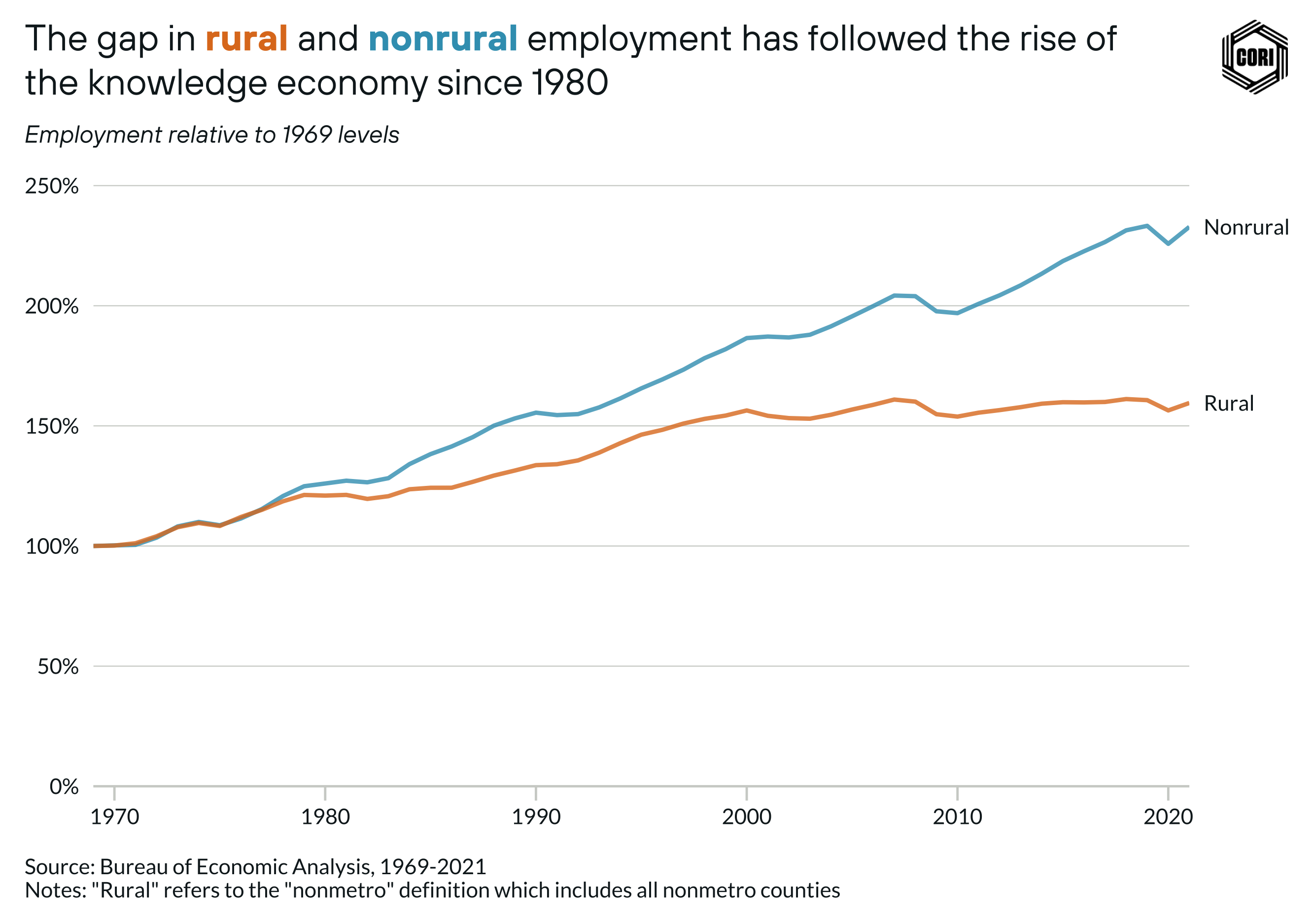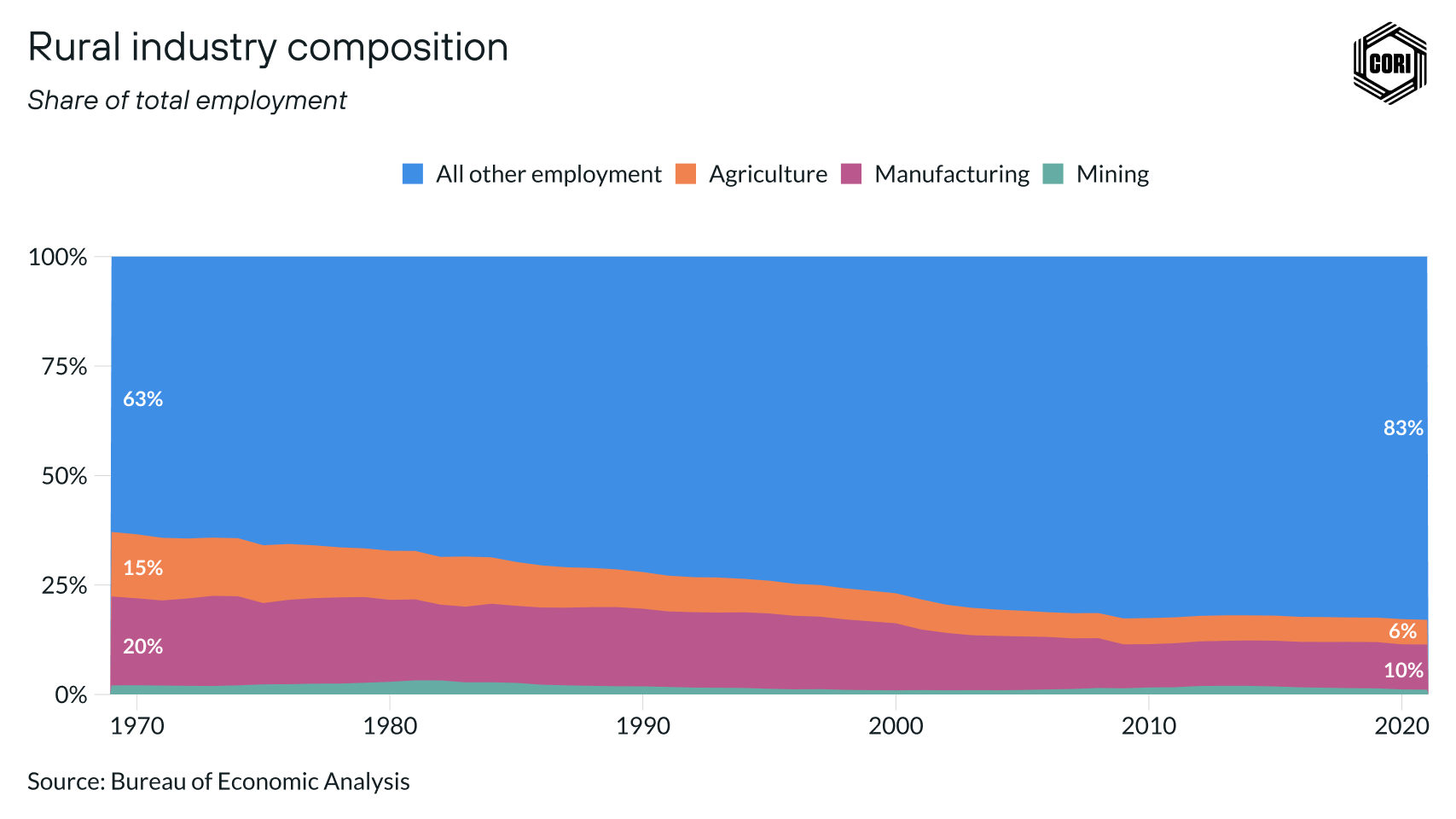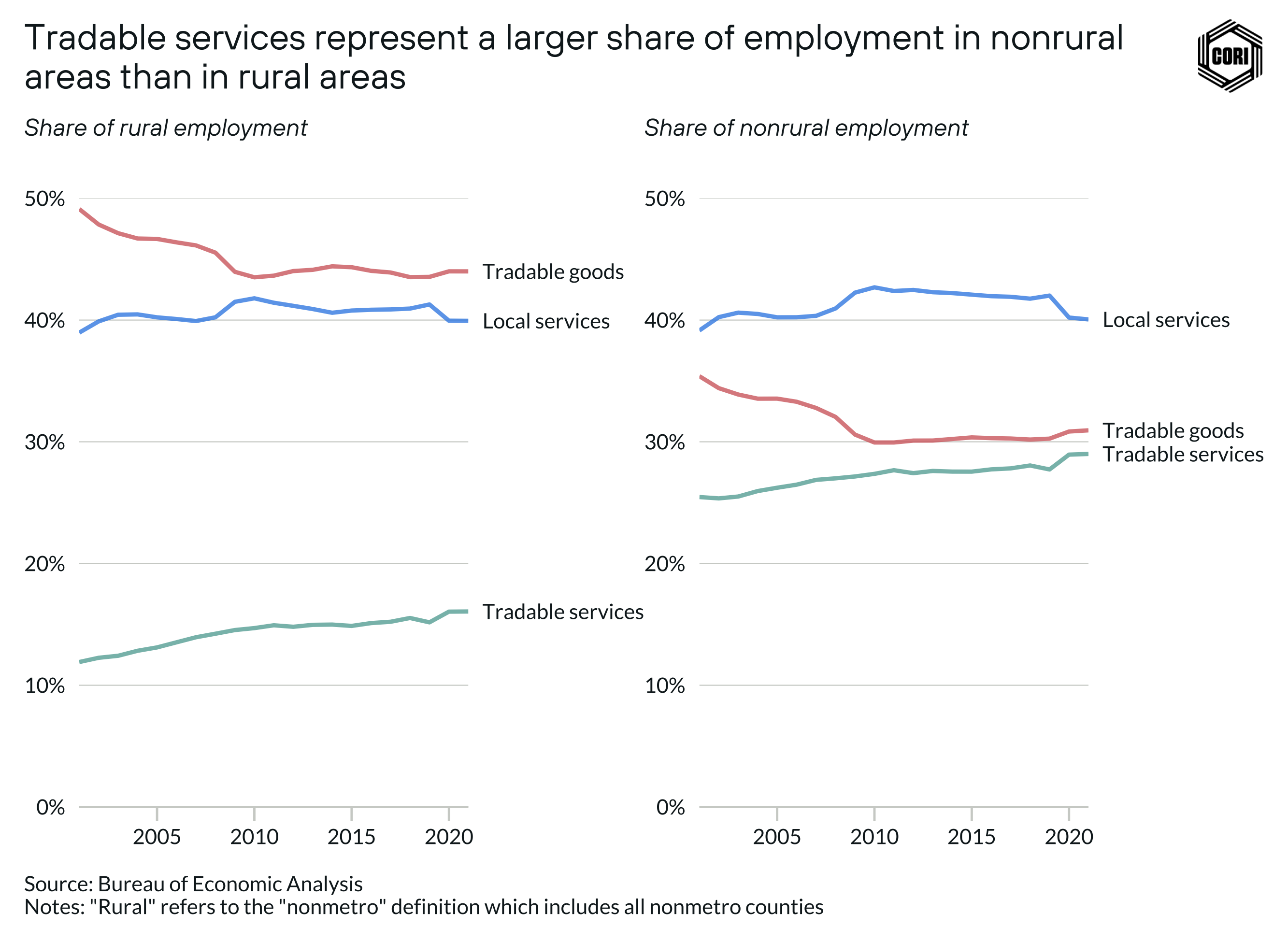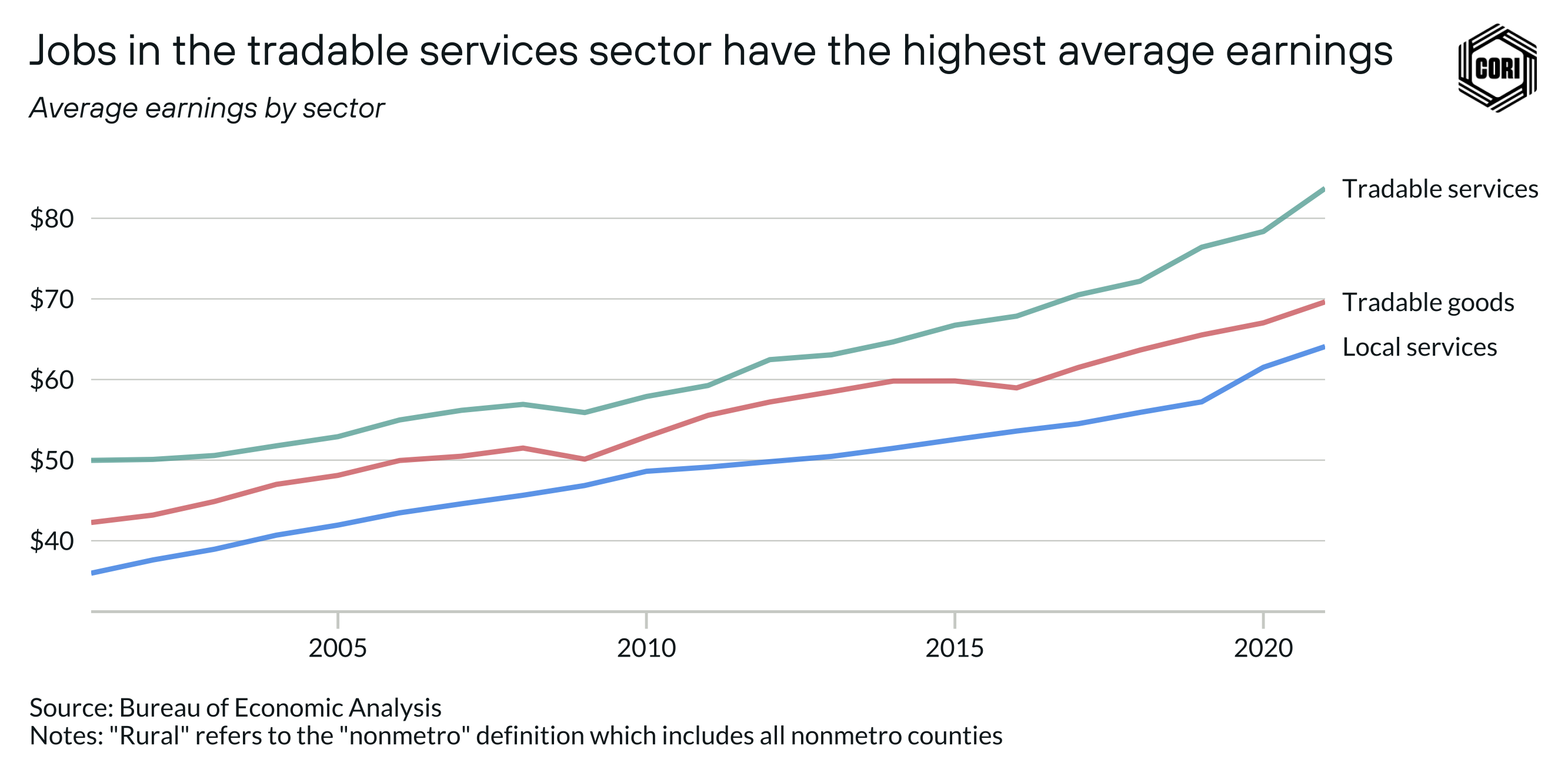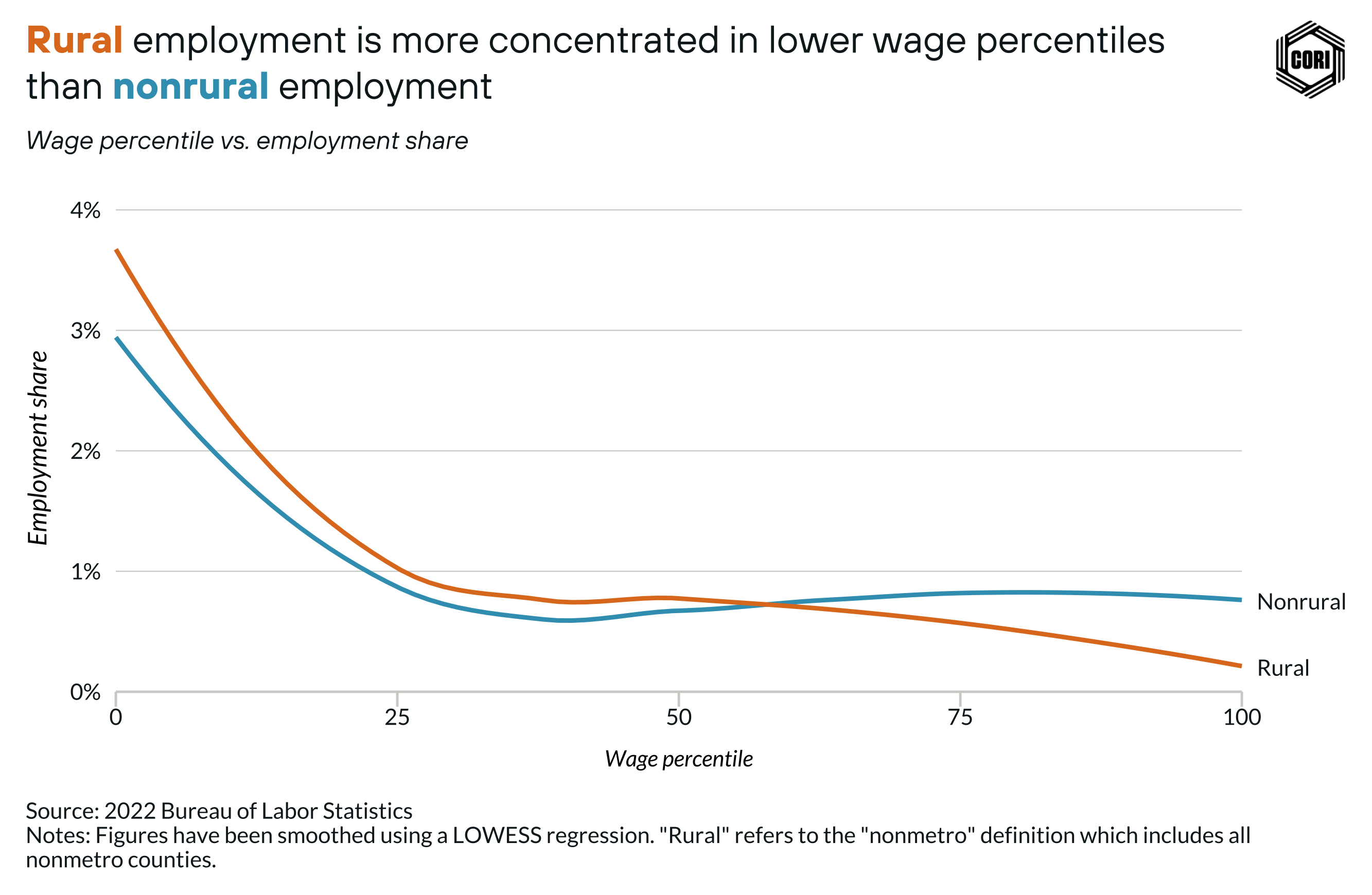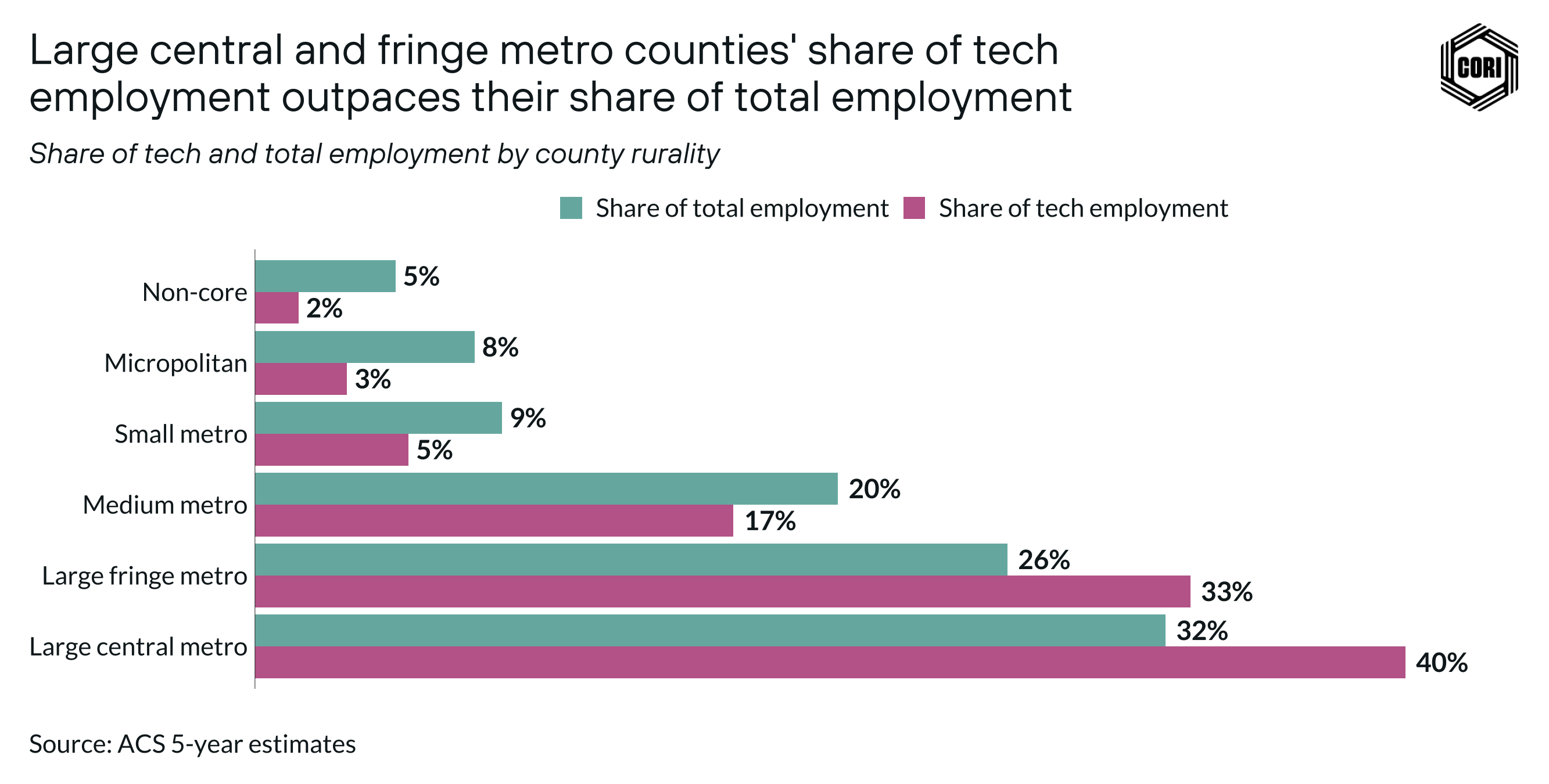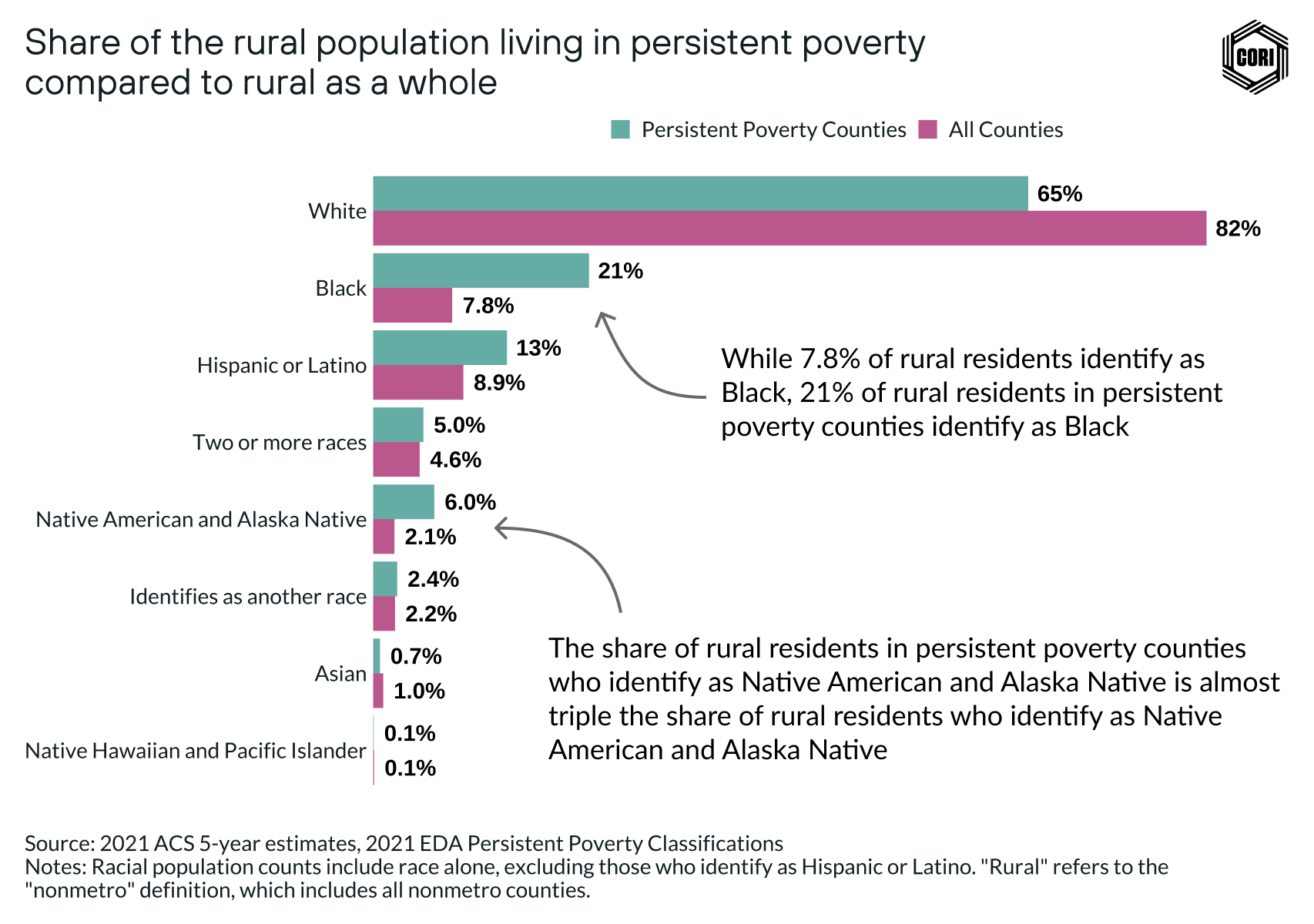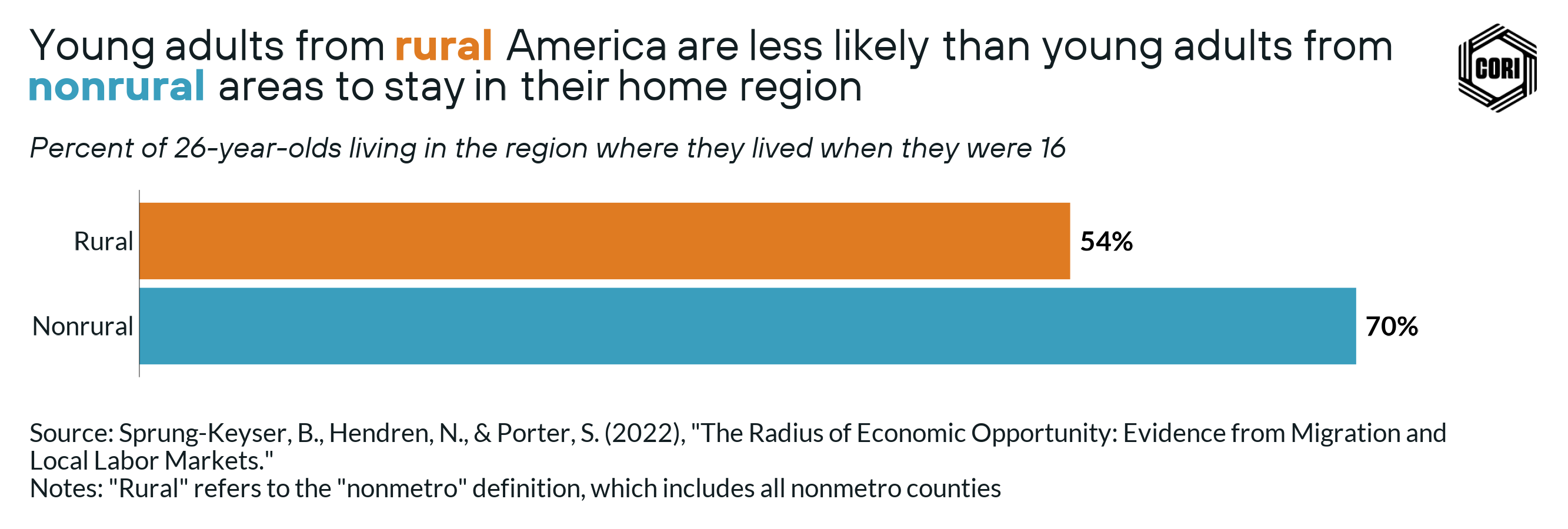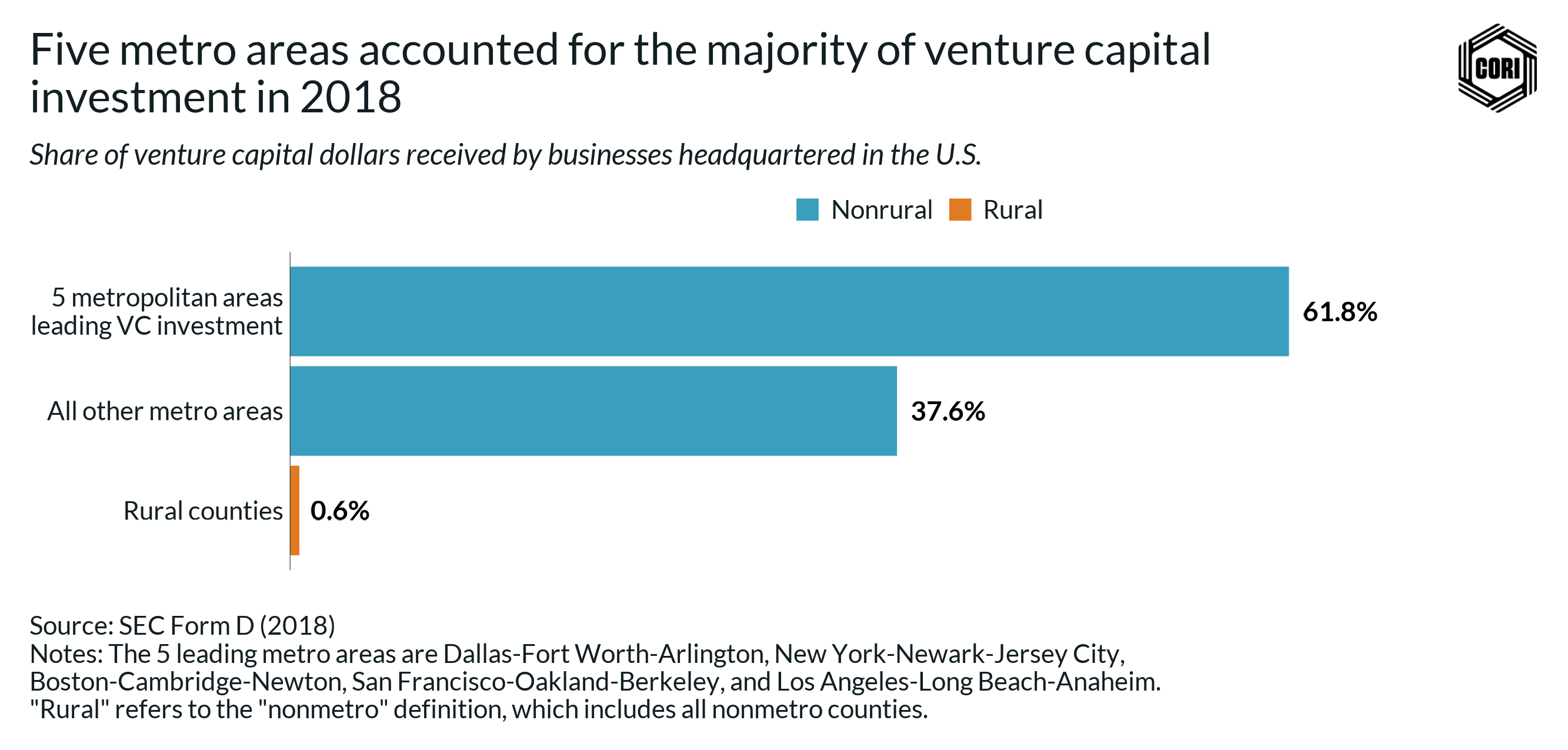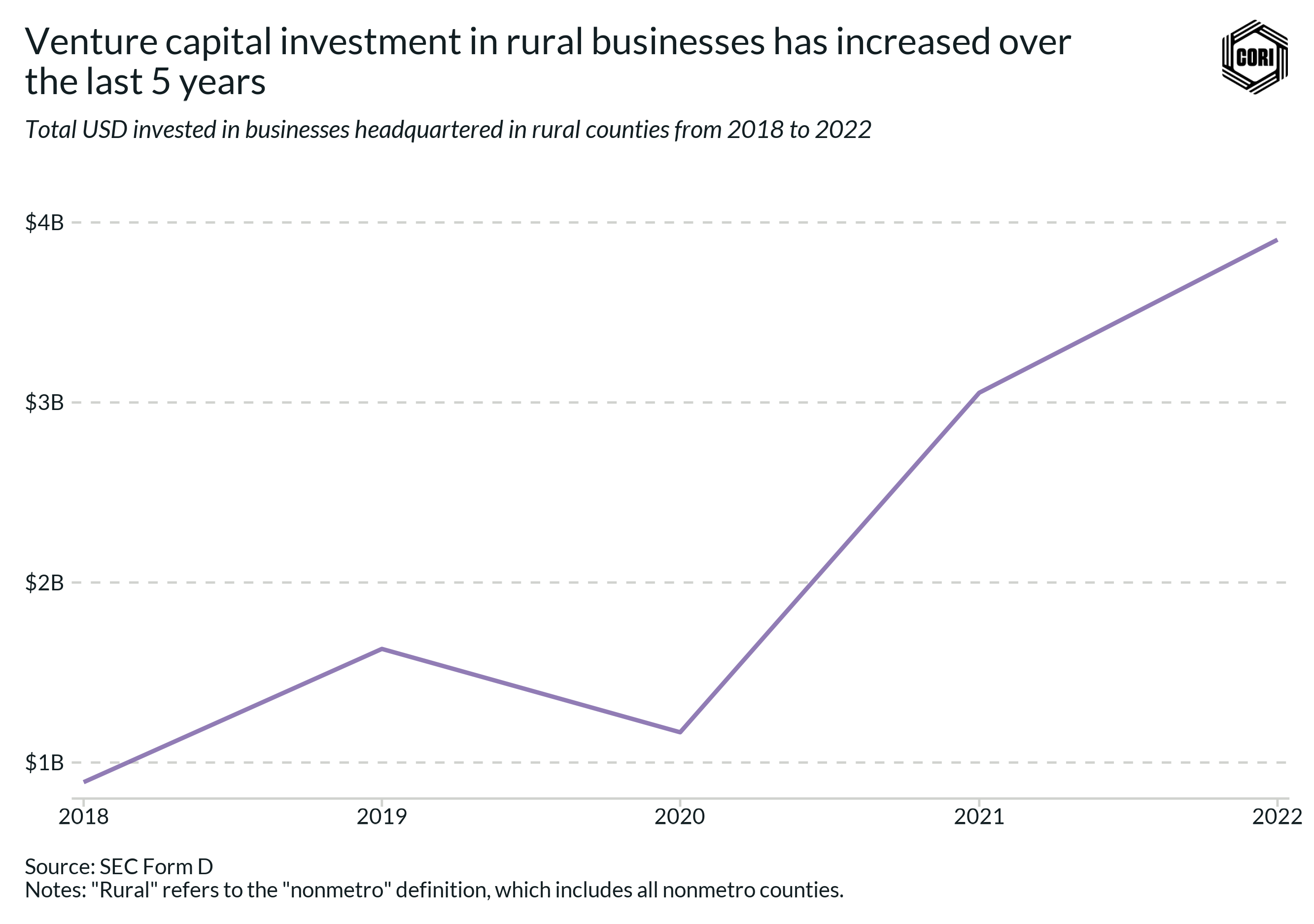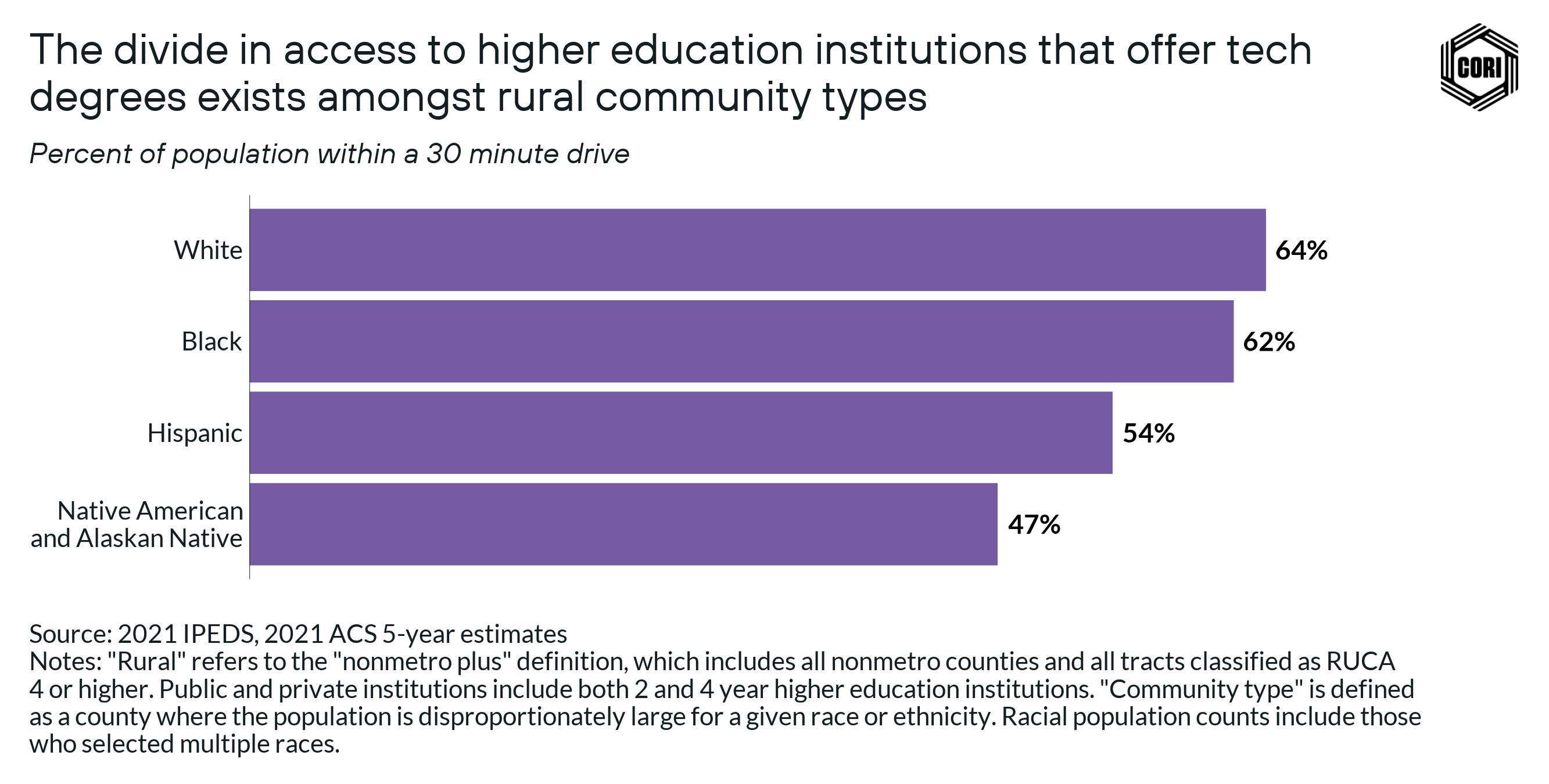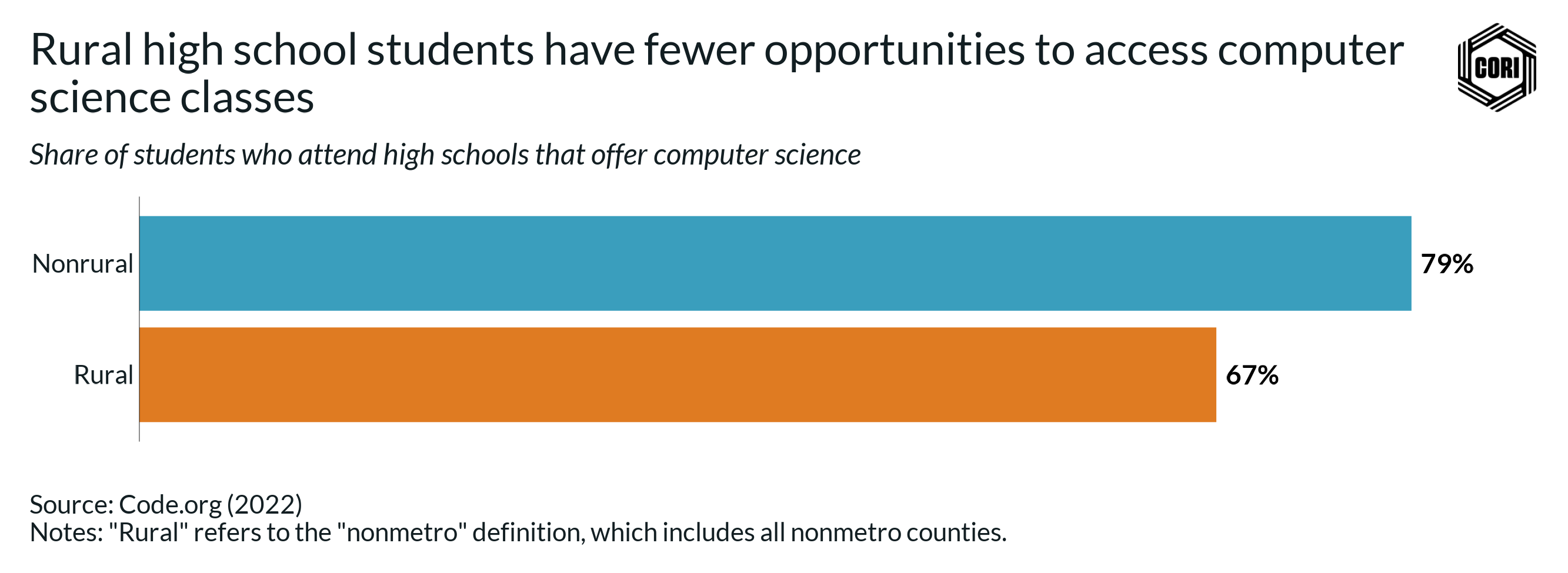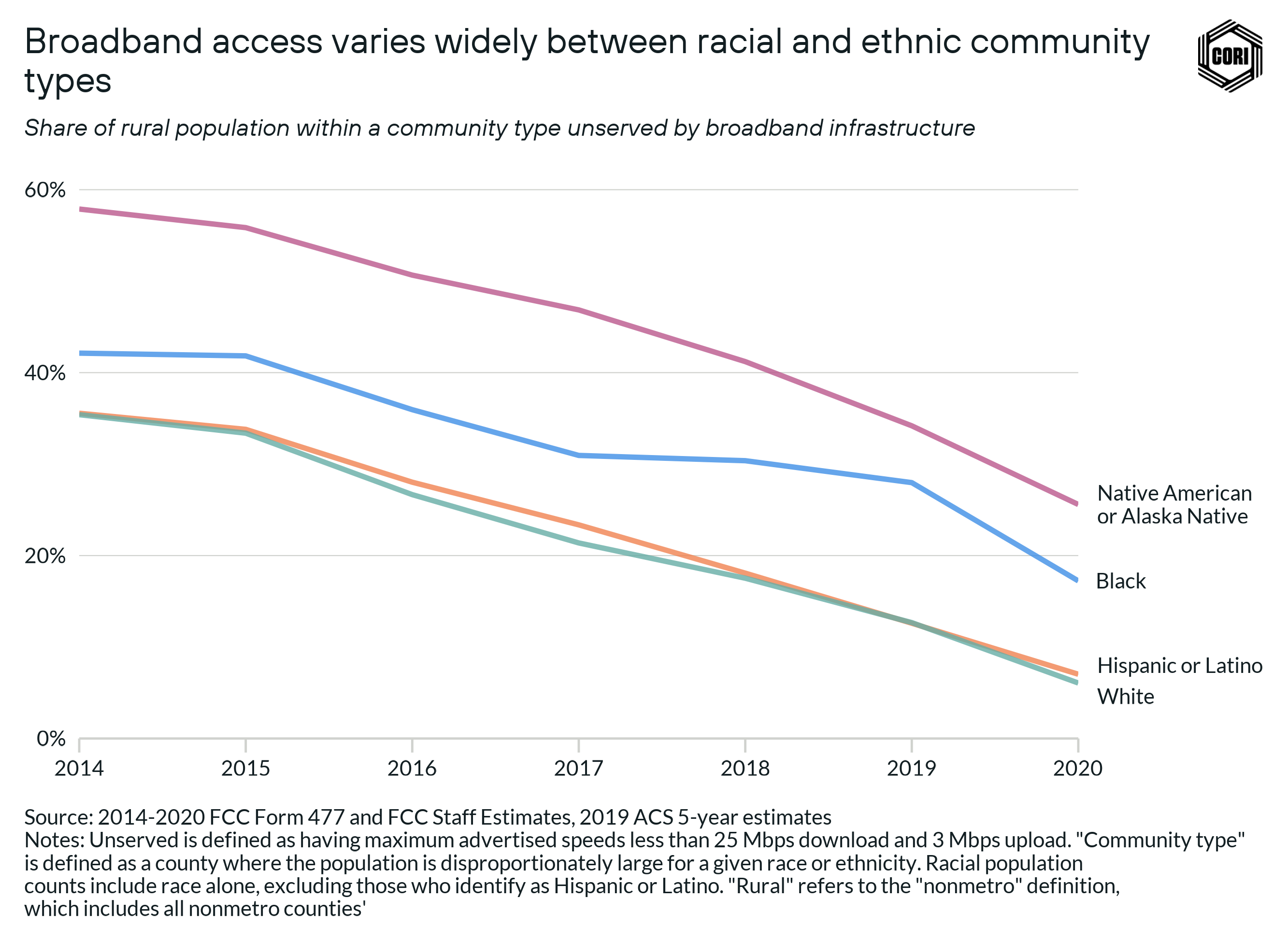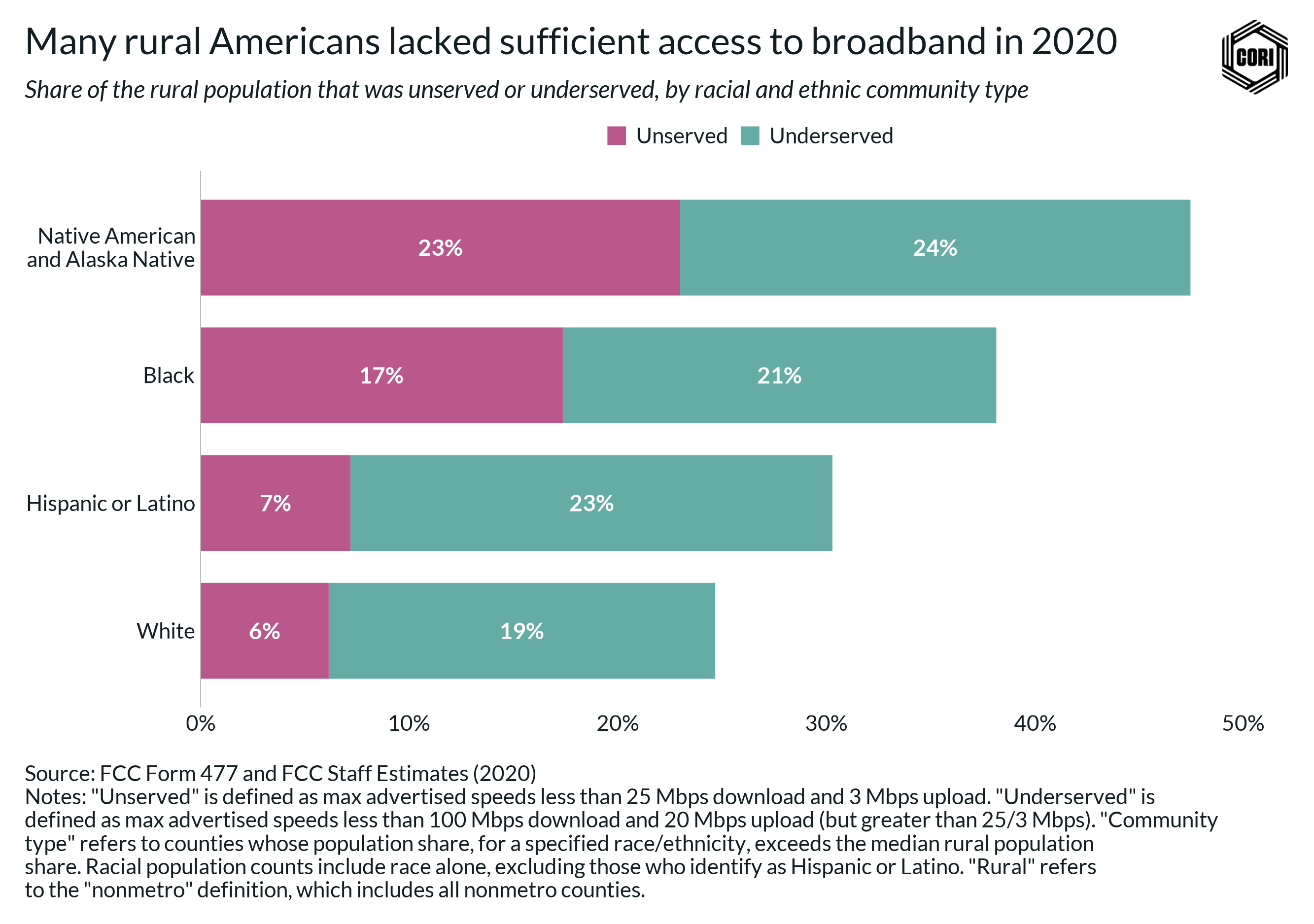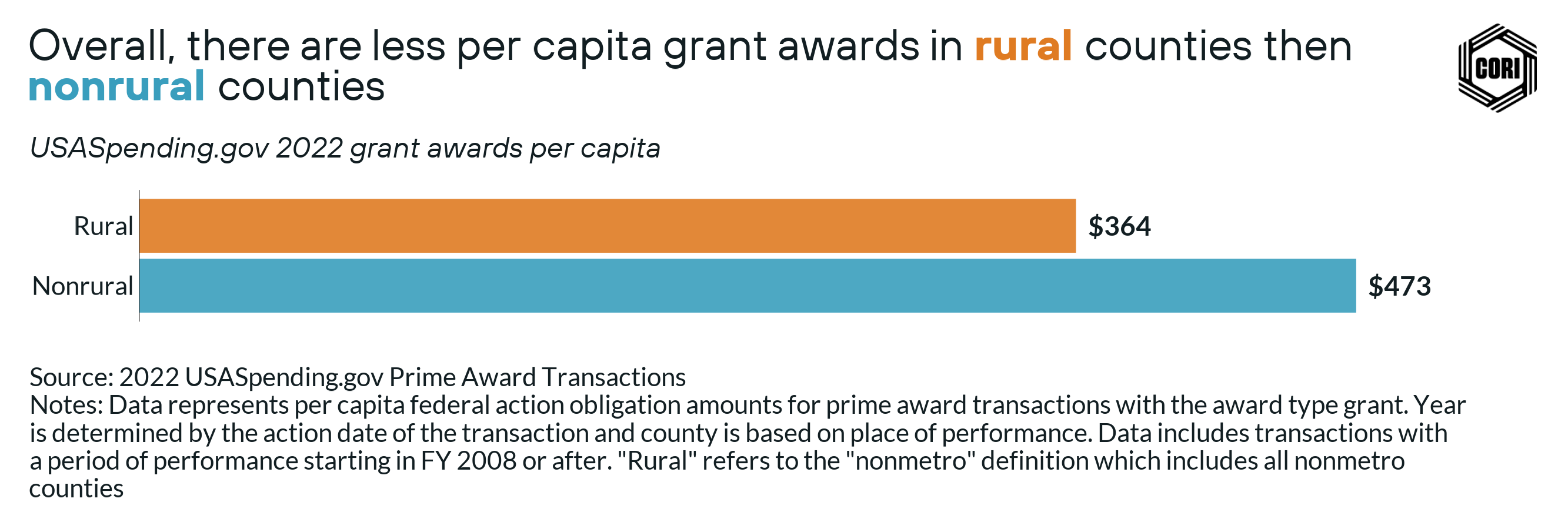Disparities in social and economic outcomes between rural and nonrural communities have been well-documented for decades.
Recently, the rise of the knowledge economy, driven by technological advancements, has accelerated economic inequities, and the concentration of key ingredients supporting knowledge economies in large cities has only intensified this trend (Moretti, 2013; Gbohoui et al, 2019; Muro & Perry, 2020). 
These are patterns of economic disparity that we can see repeating and amplifying over time: By December 2022, 63% of rural counties had fewer jobs than they did before the Great Recession in August 2007, while nonrural counties had both recovered and exceeded their pre-recession employment (BLS).
And zooming out even further from the present day, we can see evidence of this trend over the last half-century as a gulf emerged between rural and nonrural employment:
Economic opportunity also starkly varies by race, location, and class.
About 80% of counties with long-term, persistent poverty are rural, and in approximately 25% of those counties people of color make up a higher share (2021 ACS). These trends bear out in other indicators of economic wellbeing too. While overall employment in rural areas has increased by 7% in the last 10 years, employment in Black and Native American or Alaska Native communities has increased at a far slower rate, 3.4% and 3.3% respectively (2012 & 2021 ACS).
In addition to the slower overall employment growth experienced in rural areas since 1970, the primary industries that are most often associated with rural economies actually decreased in their share of the total employment in rural counties. Agriculture, manufacturing, and mining now account for less than 25% of rural employment, in large part due to automation technology:
Yet, as these traditional rural industries became less significant contributors to rural employment and economic activity, there has not been a corresponding shift in attention toward the industries that comprise the knowledge economy, nor toward the inputs needed to grow these industries. The continued focus on those traditional rural industries by policymakers and others has diverted attention from addressing the broader needs of rural communities.
But investing in rural knowledge economies has become crucial as regional divergence continues to widen.
These investments are not just critical for rural economies, but also to the health and wellbeing of rural residents because economic stability of a community is shown to have a direct impact on the people who live there. Diminished economic growth means less money flowing through a community to support the institutions that allow a place to thrive — schools, hospitals, small businesses, and cultural establishments. The economic marginalization of some rural communities has contributed to declines in educational attainment, worsening health disparities, population loss, and more (Rural Health Information Hub, 2022).
Knowledge economies, meanwhile, expand educational and financial access, and create new opportunities for social and economic mobility, helping to break cycles of poverty.
In order for rural Americans to realize the benefits of the country’s increasing prosperity we must diversify rural economies and invest in their ability to participate in and create their own knowledge economies. All too often this is a critical economic development focus that is put aside in rural development efforts in favor of the more immediate benefits of attracting traditional production businesses.
We tend to think of cities as the necessary homes of technological innovation, and rural areas as places that, by contrast, have not been able to keep up. However, we rarely discuss the mechanisms behind why that has been true, and what could be done to adapt them for rural settings.
In this third story of our Rural Aperture Project, a multi-story series funded by the Robert Wood Johnson Foundation’s Thrive Rural initiative, we’ve set out to understand the equity of economic opportunity in rural America. We explore how the booming knowledge economy of the last four decades has contributed to the growing disparity in opportunity between rural and nonrural places, the underlying context for how that happened, and how we can begin to address it going forward.
It is important to apply an equity lens to how we understand these disparities, because we know that existing economic forces are systematically benefitting certain populations at the expense of others. Rural populations in particular have been geographically marginalized over time and bear the brunt of this economic burden (Breathitt, 1967; Rasmussen, 1985; Pipa & Geismar, 2022; Frederick & Ortiz, 2020). And rural residents of color face even more obstacles due to the intersection of structural racism and geographic marginalization (Horne et al., 2021; ChangeLab Solutions).
Using equity as an analytical tool allows us to explore these intersections of place, race, and class in how rural people are able to access economic opportunity in the U.S. It helps us understand that the current economic disparities faced by many rural residents are not a failure of rural areas.
This didn’t happen because people in rural areas aren’t trying hard enough or aren’t smart enough. Rather, it’s because there are policies and biases that have concentrated resources and investment elsewhere, making it harder for rural areas to compete (Pipa & Geismar, 2021). As the saying goes, every system is perfectly designed to get the results it gets. The complex system that is our American economy is, in its current form, designed to keep rural America poor whether we realize it or not. If we want a different outcome, we need a different system.
Adopting an equity lens will allow us to unpack the systemic barriers and advantages that have led to the concentration of economic growth in a handful of urban areas and the exclusion of rural areas from participating in the knowledge economy. For this we utilize a framework adapted from the Urban Institute that asks us to look not just at the outcomes of inequity, but also to trace back the many different root causes that might be beneath them by examining:
- The historical context of the issue
- The quality of resources or benefits available to specific groups
- Equity in the distribution of and access to resources or benefits (Lewis & Martín, 2019)
- Procedural fairness in the “structures, institutions, and systems” relevant to the issue
Understanding these root causes will allow us to craft the right solutions to these issues — otherwise we risk finding the right solution to the wrong problem.
Acknowledgements
This project would not have been possible without the valuable insight, critique, and feedback from our collaborators who are embedded within a diverse array of communities, organizations, and institutions across the country, and helped to ground-truth our narrative framing and data. Thank you to Aspen Institute Community Strategies Group, MDC, Partners for Rural Transformation, Race Forward, and Regional Research Institute at West Virginia University for their wisdom and support.
Table of contents
• Historical context
• The impact of tech and knowledge economy jobs
• Equitable distribution and accessibility of key ingredients for the knowledge economy
• Procedural fairness: Bridging the policy gaps for future-focused knowledge economies
• Looking forward
• Resources

Historical context
Technological advances in the 19th and early 20th centuries spurred economic growth and productivity. However, since the 1970s, globalization and the shift toward the knowledge economy has coincided with greater regional inequality and a decline in the core industries in rural areas. It is important to acknowledge that economic benefits are not uniformly distributed. Without appropriate and sufficient interventions, the concentration of poverty in rural regions may continue to perpetuate, impacting future generations.
For decades rural Americans have been burdened by geographic discrimination, racism, and classism. Rural communities have frequently been the last to receive critical infrastructure that would otherwise allow them to participate in emerging industries — electricity in the last century, broadband internet this century — and have been built around supporting extractive industries.
Together, these factors have sent many rural communities into cycles of disinvestment and decline, making it harder for them to build positive economic momentum.
Throughout the 19th and 20th centuries, advancements in agricultural technology, such as mechanized equipment, led to increased productivity and reduced demand for manual labor in the sector (Dimitri, Effland, & Conklin, 2005; Goetz, Partridge, & Stephens, 2017).
This shifted the landscape of economic growth and the development of rural America. As innovations in machinery, tools, and methods streamlined processes, the percentage of the U.S. workforce employed in agriculture went from 41% to 4% between 1900 and 1970, and many of these workers shifted into factory jobs (Dimitri, Effland, & Conklin, 2005).
The adoption of these technologies allowed for factory towns to develop in new places across rural America, aided by the expanded availability of electricity and, later, the growth of the interstate highway system, attracting displaced agricultural labor and leading to the “densification” of rural areas that eventually grew into smaller cities and industrial hubs.
This industrialization brought about a boom in prosperity, enabling these places to catch up to more developed regions of the country (Eckert, Juneau, & Peters, 2023; Barro & Sala-i-Martin, 1992; Phelps, 2021). During this period, the economic growth occurring within rural counties meant local workers didn’t have to leave to find economic opportunity — but it also came without the scale necessary to draw external labor pools into these new hubs (Eckert, Juneau, & Peters, 2023).
These technological advances proved economically beneficial to rural areas in many respects, but laid the groundwork for impending economic shifts that eventually displaced many rural jobs.
However, industrialization didn’t benefit all rural Americans. Agricultural workers were often excluded from labor laws, which hindered their ability to unionize or advocate for fair wages and better working conditions (Ajilore & Willingham, 2022; Hardy, Logan, & Parman, 2018). And it’s essential to note that during the 19th century, a significant portion of farm labor in the South was forced upon enslaved Blacks.
Even after slavery ended, many Black workers found themselves trapped in the unfair system of sharecropping. White farm workers who didn’t own land faced challenges too, often being ignored by rural development and aid projects (Ajilore & Willingham, 2022; Horne et al., 2021). During the 19th and early 20th centuries, U.S. policies systematically displaced Native American tribes from their ancestral lands, with policies like the 1886 General Allotment Act that sold off Native land to non-native people and geographically segregated rural Native populations (CORI; Urban Indian Health Commission; Lofthouse & McKinley, 2022; Horne et al., 2021).
Widespread discrimination and segregation limited access to essential resources like education and healthcare for rural people of color as well as non-landowning white workers. The geographic concentration of these populations coincided with that of low-wage workers in rural areas who were frequently subjected to the influence of a small number of dominant local industries (Shaefer & Edin, 2023; Goetz et al, 2017).
This dynamic trapped many regions in cycles of poverty, making it difficult for both individuals and whole regions to break free from economic hardship even generations later, especially among rural individuals of color. (Hardy, Logan, & Parman, 2018; Henry-Nickie & Seo, 2022).
Indeed, industrialization sparked dramatic shifts in the economic composition of rural areas such that, by 1967, a national advisory commission admonished federal development programs for focusing too much on farms as drivers of economic opportunity. They wrote:
“Technological progress brought sharp declines in the manpower needs of agriculture, forestry, fisheries, and mining. Other industries have not replaced the jobs lost…For all practical purposes, then, most of the 14 million people in our [rural] poverty areas are outside our market economy. So far as they are concerned, the dramatic economic growth of the United States might as well never have happened. It has brought them few rewards. They are on the outside looking in, and they need help.” (Breathitt, 1967, pg xi)
The economic growth of the country, including and often led by rural areas, used to be driven by the production of tradable goods — items that can be sold or exchanged between different places, like cars, manufactured goods, or crops. But over time, automation, technological innovation, and globalization have had profound structural effects on our economic landscape, and have contributed to the rise in value of tradable services.
Since the 1970s, the rise of the knowledge economy and an intensification of globalization has significantly transformed the U.S. economy.
The knowledge economy puts a premium on knowledge, skills, and intellectual property as the key drivers of growth and competitiveness, requiring specialized workers, educational institutions, and investors for success. And the prevailing economic incentives changed accordingly as our main sources of economic growth shifted from production — the number of things produced — to knowledge creation and innovation — how innovative the product, or the means of production, is. As economist Enrico Moretti put it: “Today little value remains in the production of goods that anybody can make. Good jobs and salaries increasingly come from the production of new ideas, new knowledge, and new technologies.” (Moretti, 2013)
This period has been characterized by a notable economic shift wherein agglomeration benefits have played a crucial role. The effects of agglomeration were amplified in places where there were already concentrations of talent, resources, and potential customers.
And what emerged from these dynamics was a polarization of economic opportunity: Urban areas such as Dallas, Boston, the Bay Area, Los Angeles, and New York continued to drive growth via technology and innovation, while areas lacking such industries fell behind as workers and jobs became concentrated in those same cities (Moretti, 2013).
The lack of access to opportunities in high-growth sectors has limited economic opportunities in rural areas (Goetz et al, 2017).
Over the last 20 years tradable services have represented a larger share of the economy in nonrural areas than in rural areas, while rural employment is still largely composed of jobs reliant on tradable goods — industries like natural resource extraction, large-scale agriculture, and manufacturing that are export-reliant, making them particularly vulnerable to the effects of globalization (Goetz et al, 2017).
This disparity exists because policy and investment priorities were misaligned with the needs of a changing market, limiting rural areas’ ability to shift as quickly to tradable services as globalization and automation negatively affected their tradable goods sector.

The impact of tech and knowledge economy jobs
Knowledge economy and tech jobs are often viewed as “high quality” due to their competitive compensation, rapid growth, and resilience to automation. Research has shown positive socioeconomic benefits on communities where these jobs are present, contributing to economic mobility and a potential multiplier effect on job quantity and wages. Conversely, regions with fewer of these jobs might experience challenges in socioeconomic advancement opportunities, contributing to disparities in regional prosperity.
In a production economy, tradable goods serve as the primary growth drivers, but in our current knowledge economy, it is often tradable services — such as banking, finance, consulting, tourism, and technology — that drive the most growth. These industries provide services that can be sold to customers inside and outside of the local economy.
High-paying jobs that require advanced education are often referred to as “high quality” or “high skill” since they require more training to qualify and generally lead to greater financial stability. We recognize, however, that all labor is skilled labor, and that there are many different types of quality employment.
For the purposes of this story, we are exploring the access and benefits related to a specific subset of high-paying jobs: Tech jobs. Rural workers in computer and math occupations, frequently used as a proxy for tech jobs, earned an average of $78,843 in 2022 (Bureau of Labor Statistics). These occupations had the fifth-highest average annual wage in rural areas, and the third-highest in the U.S. overall.
There is evidence showing that these types of jobs are not only lucrative themselves but can also drive up the pay of other jobs in the local economy and stimulate job growth in other industries (Moretti, 2013). The presence or absence of these jobs, and the concentrations of these industries, is a driver for the local job market.
Recent trends suggest that many roles in this field no longer require a traditional four-year college degree. Many candidates are hired based on competency, with alternative educational routes like associate degrees, tech boot camps, and certification courses becoming increasingly viable pathways. This lowered barrier to entry is part of the appeal, offering high-paying opportunities without the necessity of a prolonged and often expensive educational commitment, and opening up access to remote training opportunities for rural residents.
Like the period of industrialization that occurred in the 19th and early 20th centuries, technological advances and automation continue to increase productivity and efficiency across many industries. Automation changes the jobs people do, the skills workers need to be successful, the structure of work arrangements, and the way workers engage with technology. Although automation can contribute significant economic gains, research has shown that it often is accompanied by increases in inequality, and that exposure to automation risk has been associated with negative health outcomes (Acemoglu & Restrepo, 2022; Gueorguiev & Nakatani, 2021; Patel et al., 2018).
This is particularly of concern in rural communities where a greater share of the workforce is employed in jobs at risk of automation, and where more jobs have a higher risk of automation.
By 2030, the sectors most susceptible to automation include: accommodation and food services, manufacturing, transportation and warehousing, agriculture, retail, and mining (Brookings). The majority of jobs in these sectors involve many routine tasks, making them prime targets for automation.
There is also a relationship between educational attainment and automation risk. Populations with a greater share of residents who hold a college degree or higher tend to be less vulnerable to the adverse impacts of automation compared to areas with low educational attainment.
Rural higher educational attainment lags that of metro populations, with roughly 14% of the rural population holding a bachelor’s degree or higher compared to 24% of the metro population (ACS 5-year estimates 2017-2021). These conditions add up to nearly half (48%) of rural jobs being at high risk of automation (CORI analysis of Frey and Osborne (2017), & 2022 BLS). Within the rural workforce, workers of color are most vulnerable to automation, with 63% of jobs held by Black and Hispanic workers at risk of automation, compared to between 44-47% of jobs held by Hispanic, Native American, and Black workers nationally.
The automation trends that risk impacting rural workers also highlight an opportunity in the increasing potential of technology-focused jobs. As traditional sectors in rural areas evolve due to automation, the innovation industries, and tech in particular, present an alternative for economic prosperity and revitalization. The growth in tech employment has had a critical impact on economic development because technology and technological advances are generally at the heart of many knowledge economy activities (Moretti, 2013).
Additionally, studies have found that each tech job leads to the creation of three to five additional jobs in the local economy, an outcome referred to as the “multiplier effect” (Bartik & Sotherland, 2019). This helps to expand demand across the broader local economy — including retail, restaurants, and healthcare — which leads to increased employment in those sectors as well. Research has shown that overall earnings are positively correlated with the percentage of the county population employed in tech jobs (Moretti, 2013).
Currently, the industries that comprise the highest shares of the rural economy — for example, hospitality, retail, and education — have among the lowest average annual earnings. While only 1.1% of rural workers were employed in computer and math occupations in 2022, these workers earned more on average than 86.3% of rural workers in other occupations that year (BLS).
Not only do these lower wages present their own economic hardship, but these jobs often do not have the multiplier effects that tech jobs have in terms of stimulating greater job creation (Moretti, 2013).
It is important to note that an area having a high share of employment in jobs that are likely to be impacted by technology does not mean that the area is destined for economic decline. Increased automation and reliance on technologies will require workers in these areas to increase their technical and specialized skills. The risks to communities, however, lie in the potential inability of a region to help workers make this transition.
If workers are unable to access training, either through their employer or the workforce system, they may not be able to adjust to the new demands of jobs being impacted by automation, or to shift into a new occupation that is complemented by technology and automation. This dynamic can erode both business and worker productivity, making the region less competitive and susceptible to economic decline.
In addressing these widening rural-urban economic disparities, it is essential for policy and resource allocation to adapt and not solely focus on attracting more of the same kinds of jobs being replaced. By embracing diversity in economic strategies and fostering local innovation, we can empower rural areas to thrive in the rapidly evolving knowledge economy. Rural Development Hubs provide a model for what this kind of place-based and people-centered economic development planning could entail. This model involves organizations anchored in a community collaborating with people and organizations across a region to promote inclusive wealth, enhance local capacity by identifying existing community assets, and aligning those assets with market demand.

Equitable distribution and accessibility of key ingredients for the knowledge economy
There are important drivers necessary to build and sustain knowledge economies, and tech economies in particular. These include a workforce with particular skills and investment opportunities for scalable entrepreneurial ventures that could expand job opportunities. But access to these drivers of tech economies is not equitably distributed between rural and nonrural communities.
Distribution: Where are the jobs located
In the last 40 years, the knowledge economy has created incredible prosperity for a specific subset of the population, but the overwhelming majority of tech jobs have become concentrated in large cities. In rural communities, we see lower concentrations of both the knowledge economy jobs broadly, and the tech jobs in particular, that have driven much of the economic growth in large cities (Moretti, 2013; ). Between 2010 and 2022, 98% of computer and math jobs, an occupation category often used to estimate tech jobs, were created in metro areas (ACS).
Relative to their share of the population, large central metropolitan areas still hold a disproportionate share of the nation’s tech employment, a reality that deprives rural workers and communities of the benefits they provide
Many of these jobs have been accessible primarily to white, college-educated people, a trend that also bears out across rural communities — shown above as non-core and micropolitan counties — where 85% of rural America’s tech workers are white and 71% are men (2018 ACS).
But these tech jobs are neither evenly distributed nor equally accessible across rural America. Counties with a disproportionately large white population have significantly higher shares of tech employment than counties with disproportionately large shares of other races and ethnicities.
These intersections of race and place further illuminate disparities.
Rural residents, and especially rural communities of color, have less access to the job stability and economic opportunity that come directly from tech employment. And without tech employment, rural communities miss out on the secondary benefits that come from having these types of jobs because the economic growth these jobs create also drives the creation of other jobs within an ecosystem (Moretti, 2013).
Yet, where tech jobs are able to grow is very much tied to investment and to the location of strategic assets that support these industries. These jobs are the outcomes of a system of resources and infrastructure that we will discuss in following sections. When economic opportunities are limited over generations of disinvestment, as has been the case for many rural communities as described in the previous section on historical context, these necessary assets become rarer and require more intentional investment to repair (Frederick & Ortiz, 2020).
This disinvestment is often apparent in another economic outcome: persistent poverty, also known as generational poverty. Of all the U.S. counties that have experienced persistent poverty since 1990, at least 80% have been rural, and within these rural counties, 25% have a non-white majority population (CORI calculation using Census & ACS ).
The economic disparities between racial and ethnic groups living in rural geographies can sometimes be obscured by small population sizes, which is why it is important to look at the differences in the magnitude of these disparities. For example, although the Native Americans and Alaskan Natives only make up about 2% of the overall rural population, they represent 6% of the overall rural population living in persistent poverty counties (2021 ACS).
The rural Black population experiences persistent poverty at the highest rate of all racial and ethnic groups, with over 21% living in persistent poverty counties in 2021 despite only making up 7.8% of the overall rural population (ACS).
The Economic Innovation Group’s recent report finds that persistent poverty is more than just a concentration of people experiencing poverty, but rather it creates regions that perpetuate poverty and increase suffering across many different socioeconomic indicators such as poor health outcomes, more exposure to violence, higher stress, higher detachment from the labor market, and others (Benzow et al., 2022).
Although the polarization of opportunity has been playing out across all types of geographies, rural places are often dropped from the conversation entirely. Rural workers often must move to urban areas or commute long distances to access job opportunities in metropolitan areas. There is also research that suggests that college graduates with student loan debt have been more likely to leave rural areas and move to cities, and that a higher debt burden increases the likelihood of this outcome (Tabit & Winters, 2019).
This contributes to brain drain, which we can see in measures like the “stay rate” of young people, the percentage of 26-year-olds living in the same region where they lived when they were 16. Rural 26-year-olds are significantly less likely to live in the same region where they grew up than those who grew up in or closer to a metro area.
Population movement is not in and of itself a problem, but when there is a continued net loss of young or highly educated residents it can pose a risk to rural economies through loss of workers, shrinking tax base, and smaller consumer base for local businesses (ChangeLab Solutions, 2023).
Access to knowledge economy inputs
What would it take to bring more of these tech employment opportunities to rural places?
Knowledge economies require certain inputs in order to grow and thrive, such as a highly educated and skilled workforce, capital and the networks and infrastructure through which to deploy it, a host of specialized services, and more. Many rural areas have lagged metropolitan areas in their access to these key inputs necessary to build a tech-based economy.
Although there are many important ingredients for successful knowledge hubs, we will focus on three key categories of inputs: access to financial capital in the form of investment, human capital in the form of specialized education and training, and broadband infrastructure.
Venture capital investment
Venture capital is a form of financing often used to invest in new businesses that have high growth potential. This is an important ingredient for knowledge economies, and for tech economies in particular, because it can accelerate employment and GDP growth via support for tech-based startups (Parhankangas, 2012). Historically, venture capital has been highly concentrated in urban areas. Research shows that venture capital firms have traditionally invested in very limited geographies — those closest to their offices — and are more likely to invest in areas where they have strong social networks (Cummings & Dai, 2010; Moretti, 2013). This has translated to less investment outside of a small handful of innovation hubs, limiting a key resource required to create new economic opportunities in rural America.
We can see evidence of this disparity in where the lion’s share of venture capital investment goes. Metropolitan areas received 99% of venture capital dollars in 2018, and when the five highest-grossing metropolitan areas are removed from this calculation, a difference of 37% still exists between rural counties and all other metro areas.
At the same time, businesses headquartered in rural America, home to 14% of the population, received only 0.6% of venture capital dollars. In 2018, rural areas received just $120 of venture capital dollars per capita, while nonrural areas received $568 per capita (SEC Form D, Population and Housing Unit Estimates).
Despite the traditional patterns of venture capital firms investing close to home, the COVID-19 pandemic appears to have shifted these dynamics and data suggests that access to venture capital is expanding in rural areas.
U.S. companies received $153 billion in venture capital funding in 2018 and $233.2 billion in 2022 — a 52% increase.
During that time, rural companies increased their venture capital funding by 338%, from $891 million to $3.9 billion, an increase that more than doubled their share of venture capital funding, from 0.6% of total funding in 2018 to 1.7% in 2022 (SEC Form D).
These venture-backed businesses offer an opportunity for rural workers to gain an ownership stake in business. Startups are generally recommended to set 10%-20% of company equity aside for employees in an Employee Stock Ownership Plan (ESOP), giving employees a way to benefit directly from a company’s financial success as the company grows (Dudley & Rouen, 2021). Increasing venture-funded rural startup activity would expand the potential opportunity for rural workers to benefit financially from the success of scalable local tech startups.
Specialized workforce pipeline
Computer and math occupations are projected to have the second-highest growth (behind healthcare support) of all occupation groups in the U.S. from 2021 to 2031, an increase — 15.5% — that is expected to be nearly three times greater than overall employment growth (5.3%) in that same period (BLS).
With the knowledge economy driving so much of our country’s economic growth, the expertise and abilities of our workforce is more important than ever — and that makes training and education a vital economic development concern.
However, we know that access to and quality of education are not distributed evenly in this country. We can see this in how much farther rural residents need to travel in order to reach higher education institutions that offer tech training. These distances also mean that many rural communities miss out on the benefits of being located near higher education institutions, places that often serve as hubs for innovation, talent, and funding.
Communities that exist in education deserts, defined as living at least 25 miles from a higher education institution, have lower levels of educational attainment and lower median family incomes compared to those located within 25 miles of such institutions (Rosenbloom & Blagg 2018). And rural Americans are far more likely to live in these education deserts: Only 51% of the rural population is located within a 30-minute drive of a public institution that offers a tech degree, compared with 93% of the nonrural population. When it comes to accessing private institutions offering tech degrees, this number drops to only 25% of the rural population (2021 IPEDS).
When examined by race and ethnicity, the data suggests that rural Hispanic and Native American and Alaskan Native communities are the least likely to be located within reasonable driving distance from higher education institutions with tech programs — findings that are consistent with research showing that a disproportionate share of the Native American population live in education deserts (Rosenbloom & Blagg, 2018).
Even at the high school level, rural residents have fewer opportunities to access tech training opportunities, highlighting rural areas’ delayed ability to fully participate in the knowledge economy. The chart below shows how access to high school computer science classes in rural schools is outpaced by metro schools:
Lower educational attainment rates in rural regions, along with limited access to specialized skill sets in rural labor pools, has made it harder for innovation clusters to form in many rural regions. But the tech industry’s acceptance of a growing array of alternative skilling pathways has rendered the sector more accessible to nontraditional learners, allowing a broader range of individuals to participate and thrive in tech roles.
Broadband infrastructure
Broadband access is tied to a host of economic benefits including increases in per capita GDP, higher rates of business formation, increased property values, and more (Campbell et al, 2022; Edquist, 2022; Whitacre et al., 2014).
However, key broadband infrastructure has been slow to reach rural places, delaying their access to one of the most important resources in a world increasingly dependent on information technology for economic growth and activity. This digital divide hinders rural communities’ ability to participate in the knowledge economy, limiting opportunities in remote work, online education, telemedicine, and entrepreneurship (Henry-Nickie & Seo, 2022; Korostelina & Barrett, 2023).
Rural infrastructure inefficiencies are well-documented and recognized by rural development leaders (Campbell et al, 2022). And until historic funding commitments made after the onset of the COVID-19 pandemic, federal policy had not effectively incentivized or intervened in private market provision, leaving millions of rural individuals unserved or underserved. As a result, rural areas have been systematically disadvantaged by missing out on the economic and social benefits that come with broadband connectivity (Whitacre et al., 2014; Henry-Nickie & Seo, 2022; ).
While nonrural access to broadband — defined by the Federal Communications Commission (FCC) as at least 25 Mbps download and 3 Mbps upload speeds — has exceeded 94% since 2014, rural broadband access stood at just 65% in 2014 and only reached 92% in 2020 (FCC Form 477 & FCC staff estimates).
When disaggregated by both geography and race/ethnicity, data shows the digital divide is even more pronounced.
As shown above, a much higher portion of the rural communities with the highest Native American or Alaska Native, or Black populations continue to lack access to broadband, and consistently have had the least access since 2014. It should be noted that there are limitations to FCC data which often represent an overcount of true broadband access due to their collection methods (Henry-Nickie & Seo, 2022)
There is also debate over what should be counted as the threshold for broadband speeds that constitute meaningful access. Many critics have argued that the current federal threshold as set by the FCC is insufficient for the demands of contemporary internet use, like remote work or online classes (Velazco, 2022; Robinson, 2023; Henry-Nickie & Seo, 2022).
If we look at broadband access using a higher speed threshold — 100/20 Mbps instead of 25/3 — we see that despite these recent gains in access a considerable portion of the rural population is still underserved and the racial disparities are even more pronounced. Even this speed, however, is below the symmetrical 100/100 Mbps speeds capable through fiber-optic networks that many people in the field are pushing for, and that new projects are prioritizing.
Within rural counties with the highest concentrations of Native American or Alaska Native residents, almost half the population was either completely unserved or was underserved by broadband access in 2020 (FCC Form 477 & ACS).
Broadband’s role as a vital economic resource means that its absence often indicates communities are at a disadvantage and potentially subjected to discriminatory practices and policies. This lack of access can be seen as punitive and as “…distinctive rural forms of digital disadvantage and vulnerability which take shape within and in turn create a variety of different forms of social, economic and cultural disadvantage” (Roberts et al., 2022).
Furthermore, the lack of reliable broadband exacerbates the challenge of developing a tech workforce when individuals don’t have a connection that allows them to participate in online, streaming-intensive tech talent development training programs.
Taken together, this critical infrastructure, along with access to financial capital and human capital development through access to education and training, represent just a few of the resources needed to strengthen and diversify rural economies. In order to support rural development and new rural businesses through start up and scaling, rural America must be a priority for more equitable, targeted, and flexible investment.

Procedural fairness: Bridging the policy gaps for future-focused knowledge economies
The current state of rural development lacks a cohesive strategy for economic growth that connects various federal programs. Private markets alone fall short in providing the essential infrastructure needed in rural areas, underscoring the crucial role of policy intervention. In this section, we explore how federal rural development policy remains closely tied to agriculture, which has led to uneven distribution and limited accessibility of resources derived from these programs. Additionally, we examine the barriers faced by certain regions.
The U.S. Department of Agriculture (USDA) is responsible for the vast majority of federal programming that serves rural regions with additional rural-serving programs filtered across myriad other federal departments. The result is an uncoordinated patchwork of more than 400 federal programs for economic and community development available to rural communities (Rassmussen, 1985; Pipa & Geismar, 2020).
Despite what would seem like a considerable investment in rural development, there remains no unified strategy for rural economic growth that connects these federal programs. Programs are often misaligned or hard to access, preventing rural communities from getting what they need to invest in their own economic futures and effectively limiting the amount of federal grants they receive.
It has also long been the case that a large number of the federal programs designed to support rural economies are heavily skewed toward agriculture, undermining rural communities’ ability to invest in and prepare for the knowledge economy (Pipa & Geismar, 2020; Pipa & Geismar, 2022; Ajilore & Willingham, 2022).
Historically, many of these economic development interventions that were intended to help the agricultural sector went to landowners and not to the laborers themselves, contributing to a concentration of rural poverty (Breathitt, 1967; Ajilore & Willingham, 2022). For example, the Farmers Home Administration, a USDA agency created under the New Deal for poverty alleviation, was not extended to non-farm households until 1961, at which time only about 1/3 of the rural population still lived on farms (Ajilore & Willingham, 2022; USDA, 2005).
Past policy discrimination against rural workers, particularly in these worker-protection laws, has contributed to the socioeconomic divide we witness today. Farm laborers not only missed out on the benefits of certain poverty-reduction policies but were also excluded from worker-friendly measures such as minimum-wage laws and the right to unionize (Breathitt, 1967; Ajilore & Willingham, 2022). This vulnerability left them to face poor working conditions, inadequate living wages, and regional concentrations of rural poverty that have continued across generations.
Although the scope of many of these programs has expanded beyond agricultural support, the overarching goals and programmatic infrastructure remain focused on support for agriculture, natural resource extraction, and, to some extent, manufacturing — all industries that have been hit hard by automation (Ajilore & Willingham, 2022). Many of these policies also disproportionately hurt rural people of color, even today (Ajilore & Willingham, 2022; Benzow et al., 2022).
Many landmark New Deal programs were implemented during periods of explicit segregation and racial exclusion, and have long-standing histories of racial discrimination, meaning that, of the resources set aside for rural communities, Black, Hispanic, Native American, Latino, and Asian populations were functionally barred from accessing them.
Today, the legacies of these discriminatory policies are still visible, perpetuating disparities between different groups. For example, the USDA is facing a number of lawsuits for both racial and gender-based discrimination (CRS, 2013; Bustillo, 2023). Another example is the complex legal and regulatory landscape that the federal government established around Native American reservations, which some have argued result in significant barriers to entrepreneurship and economic growth (Lofthouse & McKinley, 2022).
In their brief “Advancing Rural Prosperity,” ChangeLab Solutions describe the critical importance of addressing what they call the “push factors,” the socioeconomic challenges that drive people out of a rural place, and the “pull factors,” the socioeconomic opportunities that can help to retain and attract people to rural communities. It is critical to recognize the key role that policy and history play in these push and pull factors for rural areas. We have already discussed the role of persistent poverty as both an important outcome of regional disinvestment and as a driver of disconnected rural labor markets and economic distress. For policymakers, persistent poverty has served as an “alarm bell” signaling that there is a significant breakdown to be addressed in a region’s economy in order for the socioeconomic opportunities of these populations to improve (Benzow et al., 2022).
As we look to the future, a shift in the prevailing narrative among policymakers is essential. For too long, rural areas have been overshadowed by outdated assumptions, reinforced by policy decisions, that diminish the degree to which they can embrace the knowledge-based and tech sectors.
In today’s interconnected digital age, these preconceptions are rapidly becoming obsolete. With the expansion of information and communication technologies and the infusions of funding to bridge the infrastructure gap, there’s a newfound opportunity to champion the 21st-century potential of rural regions.
Recognizing that private markets alone cannot adequately address the deep-rooted issues of persistent poverty and the unique challenges faced by rural communities, policymakers must play an active role in ensuring that economic growth leads to meaningful improvements in the quality of life for all. Economic growth alone is insufficient; it requires strategic interventions and investments with an inclusive and equitable focus.
Now, more than ever, it is crucial that we capitalize on this momentum to position rural communities to fully participate in the gains of the knowledge economy and tech sector. Policymakers and community leaders must work together to create the right incentives and opportunities to foster inclusive economic development, regardless of an individual’s race, place of birth, or wealth.
This collaborative approach is essential to build thriving and resilient rural communities for the future.

Looking forward
The economic realities faced by rural communities have had significant social consequences.
Understanding these economic realities as consequences of geographic and racial inequities allows us to better grasp the urgent need for targeted interventions and equitable policies. These interventions and policies should involve rural communities at the table during all stages, including design, implementation, and evaluation of programs. They must also address the root causes of these disparities to ensure that rural communities have equal access to resources, opportunities, and the benefits of economic growth.
Examining the issue of the economic opportunity gap between rural and nonrural communities through an equity lens shows us that these disparities are not a result of the failure of rural areas or the potential abilities of their residents. Analyzing the historical context of this issue reveals that past efforts to alleviate rural poverty and support workers did not equip them with the skills and support structures needed to transition into emerging industries.
We have been here before. Just as rural electrification initiatives enabled rural areas to transition to manufacturing as agriculture evolved, broadband access can have a similar transformative impact today. However, simply providing infrastructure doesn’t guarantee high-paying jobs in the tradable economy, high-growth-potential startups, or an equitable distribution of opportunities within communities. will emerge on their own.
Today, the geographic distribution of high-paying tech jobs in urban areas and limited access to these jobs in rural areas puts the economic challenges faced by rural residents into perspective, especially communities of color, when it comes to accessing labor markets that could provide more financial stability. A look into the policy and programmatic landscape of rural development highlights the need for more equitable government intervention to bridge infrastructure gaps and provide equal investment opportunities in rural areas.
There are signs of momentum and growing opportunity that will allow rural communities to participate in and benefit from the knowledge economy. Rural communities are establishing new hubs for innovation with coworking spaces that combine access to broadband, entrepreneurship resources, tech training, and flexible office space, transforming rural downtowns. And federal policy has the potential to close the digital divide with historic investments in broadband infrastructure poised to significantly close the broadband access gap.
But providing equitable infrastructure doesn’t ensure future job quality. Relying on remote work, without a focus on fostering new knowledge- and tech-based businesses in rural areas, won’t be enough to catalyze significant community wealth and could result in a contemporary iteration of the low-wage challenges rural workforces faced during the transition to manufacturing. Policies should promote local investment, community engagement, and collaboration, while addressing systemic inequalities and diversifying economic activities for resilience.
New programs funded through the Infrastructure Investment and Jobs Act, the American Rescue Plan Act, the Inflation Reduction Act, and the CHIPS Act are creating opportunities for rural communities to access federal support to train local workers for future-focused jobs and build tech startup ecosystems, networks of different but related resources and programs that support tech economies at a systems level. In particular, place-based economic development programs offer pathways for rural communities to benefit from technological change by becoming hubs where new technology is developed and commercialized. It should be noted however that under-resourced rural communities often face significant challenges in navigating and applying for federal economic development programs, despite the potential these programs hold for transformative change (Ajilore & Willingham, 2022).
These programs and initiatives are examples of where we can start to focus our attempts to solve these economic disparities with an equity lens.
As we transition into an era dominated by knowledge and, more specifically, tech economies, we must ensure that we don’t repeat the mistakes of the past. We have a unique opportunity to ensure rural America isn’t just an observer but an active contributor to and beneficiary of these economic drivers.
By implementing inclusive policies and programs, we can work toward a more equitable distribution of economic growth and opportunity, ensuring that rural communities are not simply left behind — but instead given the chance to transform into thriving participants in the knowledge and tech economies that are driving growth in the 21st century.

Resources

